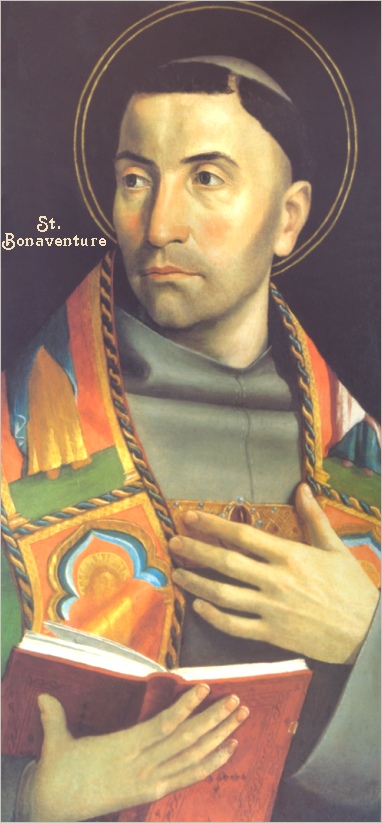
JULY 14 is the traditional memorial of ST. BONAVENTURE, BISHOP OF ALBANS (+1274).
In 1221, a son was born to Giovanni de Fidanza and his wife, Maria Ritella. They named the child after the father, hence, Giovanni, Jr. The father was a physician and a man of means. They lived in Bagneregio, in the Lazio region of Italy, the Papal States. In one of the most socially advanced areas of the Middle Ages, with money to spend, young John received a good education.
In his late teens, John entered the Franciscan Order, taking as a new name, Bonaventure, meaning Good Fortune, when he made his vows. Around the age of 21, Bonaventure was sent to the University of Paris to further his education. There he studied under the famous doctor, Alexander of Hales, and Englishman who helped establish the Franciscan School at Paris. Alexander died in 1246 and Bonaventure continued his education under John of Rochelle. In 1248, Bonaventure received his license to teach. He became a senior faculty member of the university in short time while working on his master’s (equivalent to a doctorate).
While in Paris, Bonaventure became very good friends with two important people, Thomas Aquinas and the King, himself, Louis IX. The two young men, Thomas and Bonaventure, worked on their masters at the same time, while teaching. Bonaventure captured the hearts of his students through his obvious love of Jesus and the Church. He emphasized that Jesus is the center of life. The two friends were scheduled to receive their degrees at the same time. Bonaventure, in all humility, ceded right of receiving his diploma first to Aquinas on 23 October, 1257.
In the years leading up to 1257, the Franciscan Order was in turmoil with a difference of opinion between those who followed the poverty of the patron saint and those who felt that poverty was a matter of opinion. At the young age of 35, Bonaventure was elected to become Minister General of the Order of Friars Minor and took over the role in 1257. He was able to restore calm by the judicious use of legislation and prayer. He wrote the official biography of St. Francis, recodified the constitution of the Order, and kept a steady hand on the administration of the whole. He structured and renewed the Order.
Bonaventure wrote during this period a number of spiritual works. He combined pastoral and practical aspects of life with Catholic doctrine, writing with warmth and empathy.
In late 1265, Pope Clement IV nominated him to be Archbishop of York. Due to humility and conscience, Bonaventure refused to be consecrated and the subject was dropped the next summer.
In 1273, Pope Gregory X nominated Bonaventure Cardinal and Bishop of Albano. After abdicating the role of Master General, Bonaventure was consecrated 23 June, 1273.
His work was barely begun. The pope announced the Second Council of Lyons and ordered Bonaventure to work at it. The new cardinal arrived with his secretary, Perangius of Bologna. After working to return the Greek schismatics back to the Roman Church, Bonaventure suddenly died on 15 July 1274. The secretary wrote that there may have been a poisoning. We will never know. The saint was buried in a small church in Lyons.
Due to his beautiful and easy to understand writings, St. Bonaventure was declared a Doctor of the Church in 1587.
“The perfection of a religious man is to do common things in a perfect manner. A constant fidelity in small things is a great and heroic virtue.”–St. Bonaventure


Recent Comments